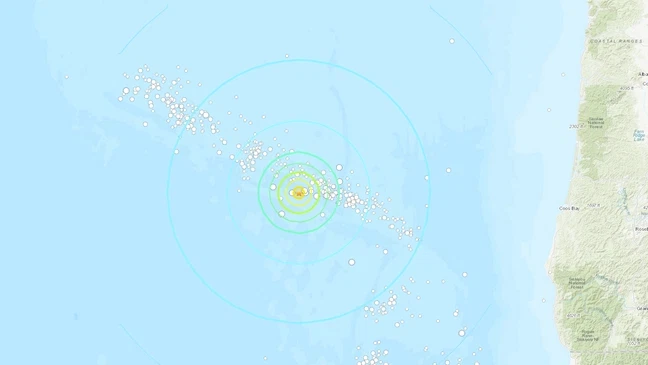A magnitude 6.0 earthquake has occurred off the coast of southern Oregon, but there is no threat of a tsunami.
PORTLAND, Ore. (KATU) — On Wednesday, at precisely 1:15 p.m., a magnitude 6.0 earthquake struck off the southern coast of Oregon, sending ripples through local communities and garnering attention from seismologists and emergency management officials alike. According to the United States Geological Survey (USGS), this seismic event occurred at a depth of 6.2 miles, with the epicenter located approximately 173 miles west of the coastal town of Bandon, Oregon.
The USGS and other officials have quickly assessed the situation, confirming that there is no tsunami threat associated with this earthquake. This is particularly important information, as residents along the Pacific coast are often on high alert for potential tsunami warnings following significant seismic activity. The fact that this earthquake did not pose a tsunami risk provides some reassurance to coastal communities that are all too familiar with the potential dangers of such natural disasters.
The earthquake itself took place in a region known for its seismic activity—an area situated beneath the Pacific Ocean, where hundreds of earthquakes have been documented over the years. This particular region is characterized by complex geological interactions, primarily due to the movement of tectonic plates. Seismologists have identified this earthquake as originating from what is known as the ‘Blanco Fracture Zone.’ This geological feature is significant in the study of tectonic movements and earthquakes, as it is part of a larger system where the Juan de Fuca Ridge is actively spreading.
The Juan de Fuca Ridge is an underwater mountain range that plays a critical role in the tectonic dynamics of the Pacific Northwest. As the ridge spreads, it causes the Pacific and Juan de Fuca plates to pull apart, resulting in a variety of geological phenomena, including earthquakes. The seismic event on Wednesday was classified as occurring along a strike-slip fault, which is a specific type of fault where two blocks of the Earth’s crust slide past one another horizontally. This mechanism is responsible for the release of stress that accumulates in the Earth’s crust, leading to earthquakes of varying magnitudes.
Seismologists emphasize that earthquakes of this size are not uncommon in this area. In fact, the Blanco Fracture Zone and its surrounding regions experience a number of quakes each year, some of which can be of similar magnitude. The ongoing tectonic activity in this part of the Pacific Ocean is a constant reminder of the dynamic nature of our planet’s crust and the forces that shape it.
Furthermore, the Cascadia subduction zone, located just off the coast of Oregon and Washington, plays a significant role in understanding the seismic risks in this region. This subduction zone is where the Juan de Fuca plate is being pushed underneath the North American Plate. This complex interaction between the two plates not only contributes to the region’s seismic activity but also raises concerns about potential future earthquakes that could have devastating impacts on local communities.
Given the historical context, the Cascadia subduction zone has been the focus of much scientific research, particularly regarding the potential for large, megathrust earthquakes that could exceed magnitude 9.0. Such events could lead to significant ground shaking and could trigger tsunamis, impacting coastal cities and towns. While the recent 6.0 earthquake did not pose an immediate threat of this nature, it serves as a reminder of the seismic risks inherent to living in this geologically active area.
In the aftermath of the earthquake, emergency management officials and local authorities remain vigilant. They often encourage residents to be prepared for seismic events by having emergency kits, developing communication plans, and understanding evacuation routes. The unpredictable nature of earthquakes underscores the importance of preparedness and awareness in regions prone to seismic activity.
Overall, while the 6.0 magnitude earthquake off the southern Oregon coast was significant, the absence of a tsunami threat allows communities to breathe a little easier. Yet, the event stands as a testament to the ever-present geological forces at work beneath the Pacific Ocean, shaping the landscape and the lives of those who call this vibrant region home.




